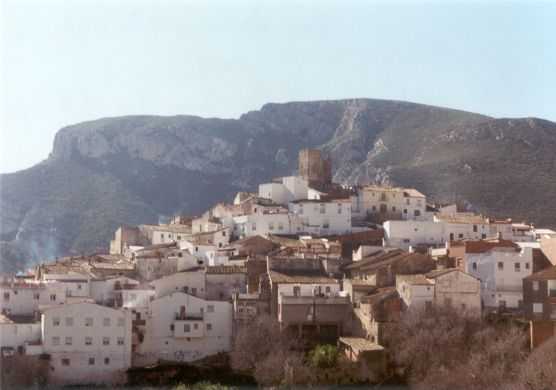Countries<Spain<Comunidad Valenciana<Dos Aguas< Restos del Castillo de Dos Aguas
King James I, on March 18, 1256, donated, in Tarazona, to Ato de Foces the towns and castles of Madrona, Millares and Dos Aguas.
Dos Aguas is a town that does not appear in the Libro de Repartimiento de la Conquista de Valencia. It was one of the towns that joined the rebellions of Al Azraq. In 1325 it was bought by Francisco Scribe. In 1349 it passed to Raimundo Castellano and later to Antonio Vilaragut and the Roig de Corella family.
Giner Rabasa de Perellós, bought Dos Aguas and Madrona with the autos made in Valencia on October 11, 1496. This gentleman was the first of the lineage Rabasa de Perellós coming from the union of Don Francisco de Perillós, of the house of Perillós of the counts of Tolosa, in France, and of Doña Juana Rabasa, daughter of Mosén Giner Rabasa, gentleman, who left heir to his grandson Giner with the condition that he took the surname and arms of the Rabasa.
Martín de Viciana, dedicated volume III of his Chronicle of Valencia, in 1563, to Giner Rabasa de Perellós, Lord of the castle of Madrona and the barony of Dos Aguas.
Later, in 1699, the barony would become a marquisate.
After the expulsion of the Moors there was a great revolt, leaving only 12 houses inhabited by Christians. The population grew from then on, with about 150 inhabitants in 1646, and 380 in 1713.
At the end of the 18th century, the botanist Cavanilles made a description of the area and its people.
Dos Aguas is located in the region of La Hoya de Buñol. The village sits on a hill 369 meters above sea level, between the ravines of the Forest and the Umbría.
The primitive nucleus is located around the castle, which occupies a higher place. It is characterized by winding streets with steep slopes and small stairways.
The castle stands out on the picturesque profile of the historic center and dominates the town and its surroundings.
At present only the tower remains, with a small crenellated wall and some annexed structures. The tower has a square ground plan with a surface area of 19 m2. It is built of rammed earth masonry.
El Rey Jaime I, el 18 de marzo de 1256, donó, en Tarazona, a Ato de Foces las villas y castillos de Madrona, Millares y Dos Aguas.
Dos Aguas es una población que no figura en el Libro de Repartimiento de la Conquista de Valencia. Fue uno de los pueblos que se unieron a las rebeliones de Al Azraq. En 1325 fue comprado por Francisco Scribe. En 1349 pasó a poder de Raimundo Castellano y más tarde a Antonio Vilaragut y a la familia Roig de Corella.
Giner Rabasa de Perellós, compró Dos Aguas y Madrona con autos hechos en Valencia el 11 de octubre de 1496. Este caballero fue le primero del linaje Rabasa de Perellós procedente de la unión de don Francisco de Perillós, de la casa de Perillós de los condes de Tolosa, en Francia, y de doña Juana Rabasa, hija de Mosén Giner Rabasa, caballero, el cual dejó heredero a su nieto Giner con la condición que tomase el apellido y armas de los Rabasa.
Martín de Viciana, dedicó el tomo III de su Crónica de Valencia, en 1563, a Giner Rabasa de Perellós, Señor del castillo de Madrona y de la baronía de Dos Aguas.
Más tarde, en 1699, la baronía se constituiría en marquesado.
A la expulsión de los moriscos hubo una gran revuelta, quedando en el término solamente 12 casas habitadas por cristianos. La población fue creciendo a partir de entonces, existiendo unos 150 habitantes en el año 1646, y 380 en 1713.
A finales del siglo XVIII, el botánico Cavanilles hizo una descripción del término y sus gentes.
Dos Aguas se encuentra en la comarca de La Hoya de Buñol. El pueblo se asienta en una colina a 369 metros sobre el nivel del mar, entre los barrancos del Bosque y de la Umbría.
El núcleo primitivo se localiza alrededor del Castillo, el cual ocupa un lugar más elevado. Se caracteriza por tener unas calles sinuosas con pendientes pronunciadas y pequeñas escaleras.
El castillo destaca sobre el pintoresco perfil del centro histórico y domina la población y sus alrededores.
En la actualidad sólo subsiste la torre, con un pequeño lienzo de muralla almenado y alguna estructura aneja. La torre es de planta cuadrada de superficie 19 m2. Está construida en mampostería de tapial. (C.Pérez-Olagüe)
